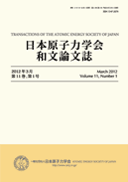Volume 5, Issue 4
Displaying 1-12 of 12 articles from this issue
- |<
- <
- 1
- >
- >|
-
2006Volume 5Issue 4 Pages 257-267
Published: December 25, 2006
Released on J-STAGE: January 21, 2010
Download PDF (5608K) -
2006Volume 5Issue 4 Pages 268-281
Published: December 25, 2006
Released on J-STAGE: January 21, 2010
Download PDF (5883K) -
2006Volume 5Issue 4 Pages 282-291
Published: December 25, 2006
Released on J-STAGE: January 21, 2010
Download PDF (733K) -
2006Volume 5Issue 4 Pages 292-304
Published: December 25, 2006
Released on J-STAGE: January 21, 2010
Download PDF (4076K) -
2006Volume 5Issue 4 Pages 305-315
Published: December 25, 2006
Released on J-STAGE: April 21, 2009
Download PDF (2020K) -
2006Volume 5Issue 4 Pages 316-324
Published: December 25, 2006
Released on J-STAGE: January 21, 2010
Download PDF (3256K) -
2006Volume 5Issue 4 Pages 325-333
Published: December 25, 2006
Released on J-STAGE: January 21, 2010
Download PDF (2334K) -
2006Volume 5Issue 4 Pages 334-346
Published: December 25, 2006
Released on J-STAGE: March 08, 2010
Download PDF (2959K) -
2006Volume 5Issue 4 Pages 347-357
Published: December 25, 2006
Released on J-STAGE: January 21, 2010
Download PDF (4243K) -
2006Volume 5Issue 4 Pages 358-363
Published: December 25, 2006
Released on J-STAGE: January 21, 2010
Download PDF (2831K) -
2006Volume 5Issue 4 Pages 364-373
Published: December 25, 2006
Released on J-STAGE: January 21, 2010
Download PDF (5174K) -
2006Volume 5Issue 4 Pages 374-381
Published: December 25, 2006
Released on J-STAGE: January 21, 2010
Download PDF (2499K)
- |<
- <
- 1
- >
- >|
